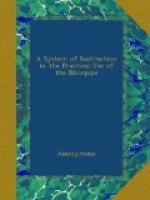Sesquioxide of Cobalt (Co^{2}O^{3}).—It is a dark brown powder. Its hydrate (2HO + Co^{2}O^{3}) is a brown powder. It is soluble only in acetic acid as the acetate of the sesquioxide. All other acids dissolve its salts to protoxide, the hydrochloric acid producing chloric gas. By ignition in the oxidation flame, it is converted into the proto-sesquioxide (CoO + Co^{2}O^{3}) and produces with reagents before the blowpipe the same reactions as the protoxide.
(c.) Nickel (Ni).—This metal occurs invariably associated with cobalt, and in analogous combinations, chiefly as the arsenical nickel. In the metallic state it is greyish, silver-white, has a high lustre, is hard, and malleable both cold and hot. At common temperatures, it is unalterable either in dry or moist air. When ignited, it tarnishes. It is easily dissolved by nitric acid, but very slowly by dilute sulphuric or hydrochloric acid, producing hydrogen.
Protoxide of Nickel (NiO).—It is in the form of small greyish-black octahedrons, or a dark, greenish-grey powder. Its hydrate is a green powder. Both are unalterable in the air, and are soluble in nitric, sulphuric, and hydrochloric acids, to a green liquid. The protoxide is the base of the salts of nickel, which in the anhydrous state are yellow, and when hydrated are green. The soluble neutral salts change blue litmus paper to red. By ignition in the oxidation flame, protoxide of nickel is unaltered. In the reduction flame and upon charcoal, it becomes reduced, and forms a grey adherent powder, which is infusible, and presents the metallic lustre by compression, and is magnetic. Borax dissolves it in the oxidation flame very readily to a clear bead, of a reddish-violet or dark yellow color, but yellow or light red when cold. If there is but a small quantity of the oxide present, it is colorless. If more of the oxide be present, the bead is opaque and dark brown, and appears, while cooling, transparent and dark red. By the addition of a salt of potassa (the nitrate or carbonate) a blue or a dark purple colored bead is produced. The borax bead, in the reduction flame, is grey, turbid, or completely opaque from the reduced metallic particles. After a continued blast, the bead becomes colorless, although the particles are not fused. If the nickel contains cobalt, it will now be visible with its peculiar blue color. Upon charcoal, and by the addition of some tin, the reduction of the oxide of nickel is easily effected, while the reduced nickel fuses with the tin.
The oxide of nickel is dissolved by microcosmic salt in the oxidation flame to a clear bead, which appears reddish while hot, but yellow and sometimes colorless when cooling. If a considerable quantity of nickel be present the heated bead is of a brown color, but orange when cooled. In the reduction flame, and upon platinum wire, the color of the bead is orange when cold; but upon charcoal, and with the addition of a little tin, the bead appears grey and opaque. After being submitted to the blowpipe flame all the nickel is reduced, and the bead becomes colorless.




